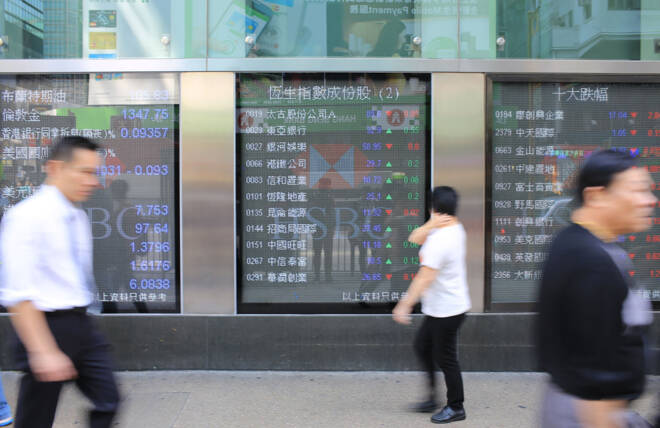Advertisement
Advertisement
Hang Seng Index and Nikkei 225: Stocks Rise on Tariff Hopes, Fed Outlook
By:
Key Points:
- Hang Seng rises 0.23%, led by real estate and tech, as hopes grow for dovish Fed and China stimulus support.
- ASX 200 climbs 0.66% after Australia's CPI cools to 2.4%, strengthening RBA H1 2025 rate cut speculation.
- Nikkei gains 0.34% as a weaker yen boosts Japan’s export outlook; Sony and Tokyo Electron post strong gains.
US Markets Rise on Tariff Sentiment and US Data
US equity markets extended their winning streak to a third session on Tuesday, March 25. Investor optimism over a potential softening in global tariff policies and supportive US economic data bolstered demand for risk assets. The Nasdaq Composite Index climbed 0.46%, while the Dow and the S&P 500 advanced 0.01% and 0.16%, respectively.
On Monday, March 24, President Trump suggested targeted reciprocal tariffs and tariff relief for many countries, easing fears of broad-based trade restrictions. The shift in rhetoric marked a notable departure from previous plans for sweeping levies on nations taxing US goods.
US Consumer Confidence Tumbles
March data showed a sharp deterioration in consumer sentiment, bolstering expectations of a more dovish Fed. The US CB Consumer Confidence Index fell from 100.1 in February to 92.9 in March, reflecting concerns about income, the labor market, and the broader economic outlook.
Waning consumer confidence could weigh on household spending and dampen demand-driven inflationary pressures. Given that private consumption accounts for over 60% of US GDP, a pullback in spending could also slow economic growth. A softer inflation outlook and potentially slower GDP growth could strengthen the case for multiple Fed interest rate cuts, supporting equity prices.
Nick Timiraos, chief economics correspondent at The Wall Street Journal, commented:
“Lowest level since January 2021 (worse than the July 2022 nadir of Biden’s presidency, when inflation hit 9%). Fourth straight monthly decline. The consumer expectations index—based on consumers’ short-term outlook for income, business, and labor market conditions—dropped to the lowest level in 12 years, just below the readings of July 2022.”
Asian Market Implications: Asian markets opened mixed on Wednesday, March 26, as traders considered tariff risks and the Fed’s policy outlook.
Hang Seng Index Gains Despite Tariff Caution
In Asia, the Hang Seng Index gained 0.23% on Wednesday morning, tracking overnight gains from Wall Street. While Trump’s latest tariff comments offered some relief, caution lingered ahead of expected new levies on April 2. Real estate stocks led the gains on hopes for a more dovish Fed, while tech stocks steadied after recent losses.
- The Hang Seng Mainland Properties Index rallied 2.21%, while the Hang Seng Technology Index added 0.52%.
- Tech giants Alibaba (09988.HK) and Baidu (09888.HK) advanced by 1.41% and 1.36%, respectively.
- Auto stocks also rebounded, with BYD Company Ltd. (01211.HK) gaining 0.98% and Li Auto Inc. (02015.HK) up 1.50%. Reports of China’s Ministry of Commerce planning pilot programs to reform auto sales and distribution boosted demand for Hong Kong-listed auto stocks.
In contrast, Mainland China’s equities edged lower on tariff uncertainty. The CSI 300 fell 0.15%, while the Shanghai Composite Index slipped by 0.02%. Losses were modest, supported by speculation of further stimulus from Beijing.
Nikkei Index Rises on Yen Reversal
Japan’s Nikkei Index advanced 0.34% on Wednesday morning as the USD/JPY recovered most of Tuesday’s 0.53% loss, trading at 150.309. A weaker Japanese Yen improved the outlook for Japanese exporters and corporate earnings.
Sony Corp. (6758) rallied 2.23%, while Tokyo Electron (8035) gained 1.43%. Softbank Group (9984) rose by a more modest 0.29%.
ASX 200 Advances as Inflation Cools
Australia’s ASX 200 climbed 0.66% as cooling inflation boosted demand for rate-sensitive sectors. Australia’s Monthly CPI Indicator unexpectedly fell from 2.5% in January to 2.4% in February, reinforcing bets on an H1 2025 RBA rate cut.
AMP Head of Investment Strategy and Chief Economist Shane Oliver commented:
“Aust Feb monthly CPI dropped to 2.4% yoy from 2.5%. Trimmed mean inflation fell to 2.7% from 2.8%. Good news but RBA unlikely to ease next week preferring to wait for the March qtr CPI next month. We still expect a rate cut in May.”
Banking, mining, and energy stocks contributed to the morning gains.
- Banking sector: ANZ (ANZ) reversed Tuesday’s 3.18% slump, rallying 3.04%, while the Commonwealth Bank of Australia (CBA) gained 1.20%. Softer inflation could boost demand for credit and drive economic activity, increasing appetite for bank stocks.
- Mining giants BHP Group Ltd. (BHP) and Rio Tinto Ltd. (RIO) climbed 1.74% and 2.01%, respectively, as copper prices soared following Trump’s tariff warning on copper imports.
- Woodside Energy Group Ltd. (WDS) rose 1.23% following the announcement of new 25% tariffs on countries purchasing oil and gas from Venezuela.
Outlook: Trade and Policy Remain in Focus
Markets remain focused on tariff developments and central bank forward guidance. Renewed US-China trade tensions could impact risk sentiment but may also prompt Beijing to roll out fresh stimulus. Such measures could potentially boost demand for Hong Kong and Mainland China-listed stocks.
Meanwhile, central bank forward guidance remains pivotal as policymakers navigate inflationary risks and geopolitical uncertainty.
Explore our full analysis here for trading strategies in today’s volatile landscape.
About the Author
Bob Masonauthor
With over 28 years of experience in the financial industry, Bob has worked with various global rating agencies and multinational banks. Currently he is covering currencies, commodities, alternative asset classes and global equities, focusing mostly on European and Asian markets.
Did you find this article useful?
Latest news and analysis
Advertisement
